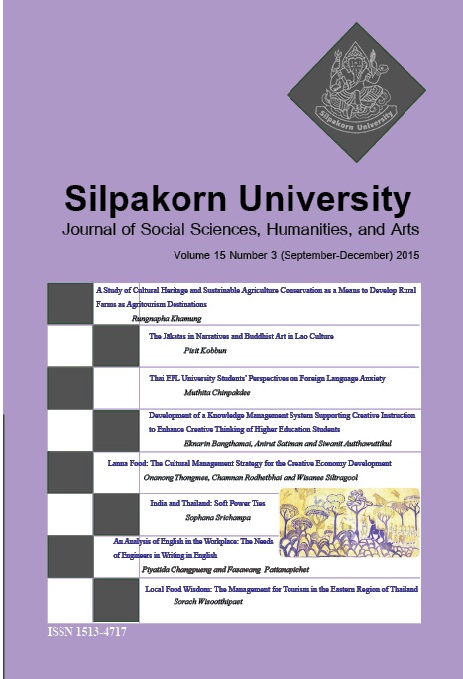India and Thailand: Soft Power Ties
Main Article Content
Abstract
India and Thailand have had a long relationship since ancient times. This relationship commenced through trade and later Indian religion and culture followed. Thailand remains influenced by Indian elements which mixed with the local beliefs and culture. There was no hard power used directly from India towards Southeast Asia or Thailand in particular. Rather, it was soft power that India used to forge ties with Thailand. Soft power means the ability to combine hard and soft power into a winning strategy. Diplomatic relations between India-Thailand in modern times started since 1947 after the independence of India. With India’s ‘Look East’ policy in 1992, and the ‘Look West’ policy of Thailand, India has implemented many collaborative works with Thailand. Nye’s concept of Power as Resources can be summarized that religio-economical-cultural resources are power through Look East and Look West Policies as its strategies. The preferred outcomes are the close relation between India-Thailand. Another Nye’s concept of Power Defined as Behavioral Outcomes: Power affects others through religio-economical-cultural resources by reward and attraction to better understanding between two people for further constructive collaborations as the preferred outcomes.
Downloads
Article Details
All rights reserved. Apart from citations for the purposes of research, private study, or criticism and review,no part of this publication may be reproduced, stored or transmitted in any other form without prior written permission by the publisher.
References
ASEAN, India Reaffirm 20-years Ties. (2012) India Calling 3(1): 22. Centre for Bharat Studies, RILCA, Mahidol University, Thailand.
Chaiyotha, D. (2007) Thai history: Ayutthya Period. Bangkok: O.S. Printing House.
Champathong, P. (2012, March 25) Benevolences of India to Thailand. Thai Post [Online URL: http://www.ryt9.com/s/tpd/ 1371939] accessed on the March 23, 2014.
Boonyawan, C. and Pechsiri, A. (n.d.) Legislative of Thailand: An Historical. [Online URL: http://www.ide.go.jp/English/Publish/Download/ Jrp/pdf/157_ch5.pdf] accessed on April 7, 2014.
Department of Tourism. [Online:http://www.tourism.go.th/home/details/11/221/24710] accessed on the 17th January 2015.
Depth of Brahman Roles of rituals. (n.d.) [Online URL: http://my.dekd.com/atidtarn/blog/?blog_id=10105683] accessed on April 6, 2014.
Greater India. (n.d) [Online URL: http://en.wikipedia.org/wiki/Indianized_kingdom#Indianised_ kingdoms] accessed on the 6th April, 2014.
Hays, J. (2014) Religion in Thailand. Religion and Buddhism in Thailand. [Online URL: http://factsanddetails.com/southeast-asia/Thailand/sub5_8b/entry-3212.html] accessed on June 27, 2015.
High Commission of India, Singapore. (n.d.) ASEAN Voyage of INS Sudarshini. [Online URL: https://www.aseanindia.com/navy] accessed on the 6th April, 2014.
History of Nakhon Si Thammarat. (n.d.) [Online URL: http://www.nakhonsithammarat.go.th/his.php] accessed on July 8, 2015.
Hussain, Z. (1982) The silent minority: Indians in Thailand. Bangkok: Chulalongkorn University.
‘Board of Investment, Thailand to initiate investment services in Mumbai to attract Indian Investors and Urge Thais to Invest in India’. (2013) The Board of Investment, Minsitry of Industry, No.106/2013(0.55), 25 June, 2013. [Online URL: www.boi.go.th/.../2013-06-25%20BOI%20Press%20Release_56568] accessed on July 15, 2015.
Kasetsiri, C. (2001) Ayutthaya and Asia. Bangkok: Toyota Thailand Foundation.
Khamwansa, S. (1979) Indian Cultural Influence in Southeast Asia (focus on Thailand). Bangkok: Aksorn Charoenthat Publishing House.
Kusalasay, K. and Ruang-uraj. (2000) Wa-tha-na-tham-sam-phan-Thai-India. (Thai-Indian Cultural Relation). Bangkok: Siam.
Lawsunthorn, N. (1972) Relationship between Thai Drama and Sanskrit Drama. M.A. Thesis in Thai Department, Chulalongkorn University, Bangkok.
Leading source countries of foreign tourist arrivals (FTAs) in India in 2014. (n.d.)[Online: http://www.statista.com/statistics/207005/foreign-tourist-arrivals-in-india-in-2010--by-source-country/] accessed on the 17th January 2015.
Lochan, A. (2006) Thailand. In The Encyclopedia of the Indian Diaspora. Singapore: Tien Wah Press Pte. Ltd.
Mishra, P. (2010) The History of Thailand. California: ABC-CLEO, LLC.Naming. (n.d.) [Online URL:http://www.myhora.com/] accessed on April 6, 2014.
Nye, J. S. (2004) Soft Power. New York: Public Affairs.
Nye, J. Jr. (2009) Get Smart Combining Hard and Soft Power. Council on Foreign Relations. [Online URL:http://www.foreignaffairs.com/articles/65163/joseph-s-nye-jr/get-smart?page=1] accessed on April 6, 2014.
Nye, J. S. (2011) The Future of Power. New York: Public Affairs. Pattaya Welcoming Wedding Parties from India. (2013) [Online URL: http://www.tatnews.org/pattaya-welcoming-wedding-parties- from-india] accessed on February 10, 2014.
Phongphaiboon, S. (1993) Lak-phasa-Thai (Thai Principles). Bangkok: Thai Watana Panich, Co.Ltd.
Phra Pathom Chedi. (n.d.) [Online URL http://www.yourthaiguide.com/phra-pathom-chedi/] accessed on February 10, 2014.
Piyaphan, B. (1995) Pra-wat-sat-Thai (Thai History). Bangkok: O.S. Printing House.
Principal Home Secretary Suresh Babu in Delhi to apprise situation to MEA and MHA State gears up to welcome ASEAN-India Car Rally. (n.d.) In The Sangai Express. [Online URL http://e-pao.net/GP.asp?src=28..131212.dec12] accessed on July 3, 2015.
Roles of Brahmans to Siamese Royal Court. (1996) [Online URL: http://kanchanapisek.or.th/kp6/sub/book] accessed on April 7, 2014.
Sanchi. (n.d.) [Online URL: http://www.shunya.net/Pictures/NorthIndia/Sanchi/Sanchi.htm] accessed on February 10, 2014.
Sansanti, V. (2015a) Brahman: Brahmanism in Sukhothai. [Online URL: http://www.gotoknow.org/posts/449346] accessed on February 10, 2014.
Sansanti, V. (2015b) ‘Linguistics: Thai alphabets development from beginning to disaster. [Online URL: http://www.gotoknow.org/posts/449330] accessed on February 10, 2014.
Sachchidanand, S. (2003) King Rama V visited India. In India in 1872: As seen by the Siamese (K.Sri-udom, Trans.). Bangkok: Toyota Thailand-Foundation.
Syamanada, R. (1986) A History of Thailand. Bangkok: Thai Watana Panich Co. Ltd.
Tamthai, M. (n.d.) THAILAND: Sakdina System and Promotion of Human Rights and Democracy. [Online URL: http://www.hrsolidarity.net/mainfile.php/1999vol09no06/1018/] accessed on April 7, 2014.
Thai-India Relations. (n.d.) [Online URL: http://www.thaiemb.org.in/en/information/] accessed on June 4, 2014.
The ASEAN-Indian Navy Expedition 2012. (n.d.) [Online URL: http:// voiceof.india.com/features/the=asean-indian-navy-expedition-2012/8083) accessed on June 4, 2014.
The Mahavamsa, the Great Chronical of Sri Lanka. (n.d.) [Online URL: http://mahavamsa.org/mahavamsa/] accessed on April 16, 2015.
The times of India. (n.d.) [Online URL: http://timesofindia.indiatimes.com/business/india-business/Thai-India-trade-likely-to-double-to-16-billion-by-2015-Thaiofficial/articleshow/22100864.cms] accessed on April 6, 2014.
Wongthet, S. (2006) Suvannabhumi: the Beginning of Thai History. Bangkok: Matichon.
Wyatt, D. K. (2003) Thailand: A Short History. New Heaven and London: Yale University.


